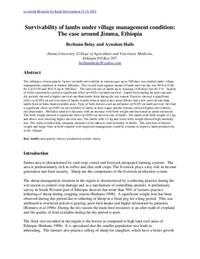Survivability of lambs under village management condition: The case around Jimma, Ethiopia

Authors:
The influence of non-genetic factors on lamb survivability at various ages up to 360 days was studied under village management condition in Jimma, Ethiopia. The overall least squares means of lamb survival rate was 89.0 at 0-60, 81.5 at 0-120 and 50.0 % up to 360 days. The survival rate of lambs up to weaning (120 days) was 81.5 %. Season of birth consistently exerted a significant effect (p<0.05)) on lamb survival. Lambs born during the post rain and dry periods showed a higher survival rate than lambs born during the wet season. Districts showed a significant effect (p<0.05)) on survival rates of lambs. Lambs born in land scarce areas (Dedo) had a low survival rate than lambs born in Seka (land available area). Type of birth did not exert an influence (p>0.05) on lamb survival. Sex had a significant effect (p<0.05) on survivability of lambs at later stages and the females showed higher survivability rate than males. Mortality tended to decrease with an increase with birth weight and decreased as parity increased. The birth weight showed a significant effect (p<0.05) on survival rate of lambs. The lambs with birth weight of 2 kg and above were showing higher survival rate. The lambs with 1.5 kg and lower birth weight showed high mortality rate. The study revealed that, adequate measures to be taken to curb mortality of lambs. The selection of heavier weight and larger litter at birth coupled with improved management could be a means to improve lamb productivity in the villages.
